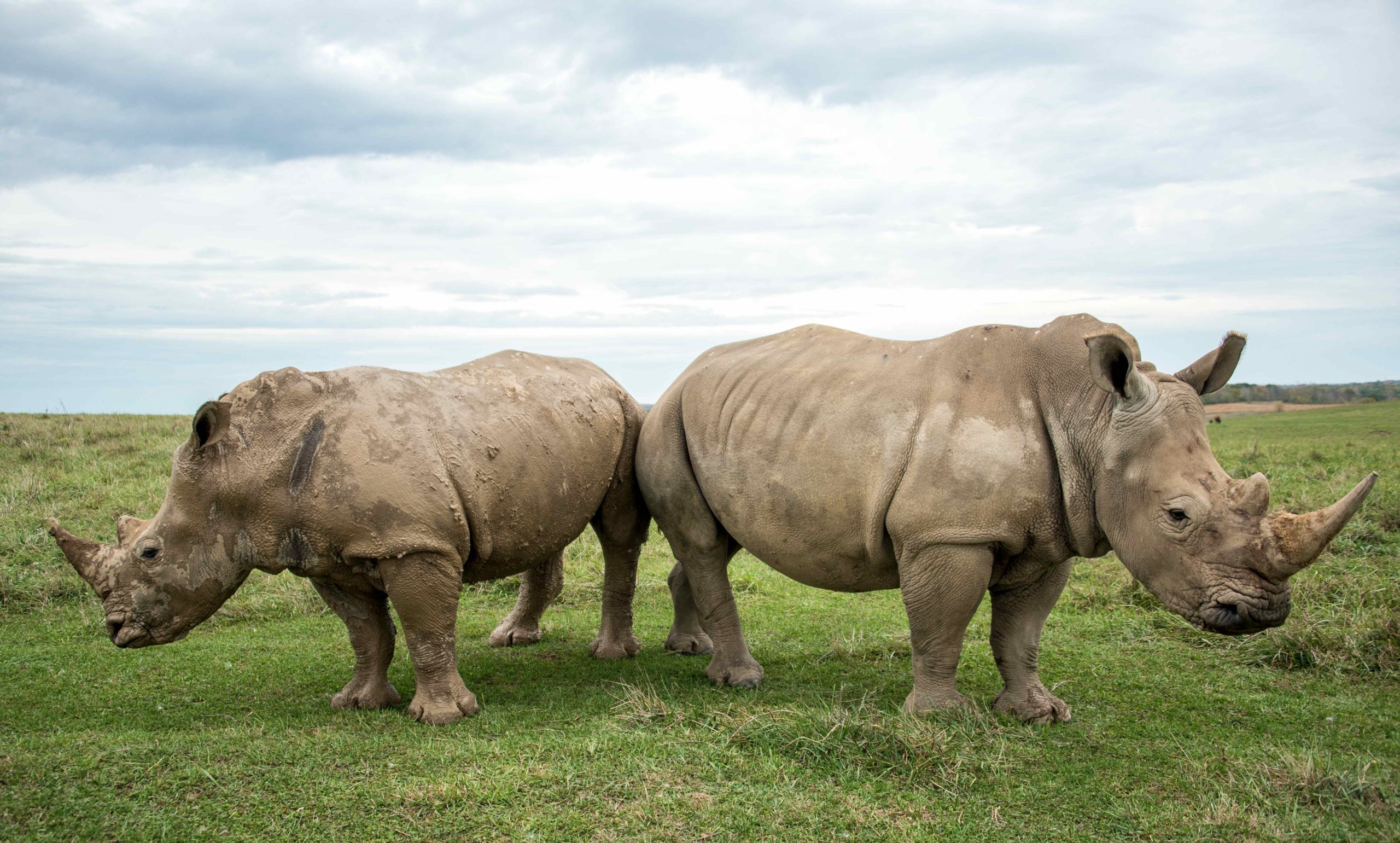2024 State of the Rhino
Every September, the International Rhino Foundation (IRF) publishes our signature report, State of the Rhino, which documents current population estimates and trends, where available, as well as key challenges and conservation developments for the five surviving rhino species in Africa and Asia.
Key takeaways from the 2024 State of the Rhino report:
- Rhino poaching in Africa increased by 4% from 2022 to 2023. At least 586 African rhinos were poached in 2023, one every 15 hours.
- While thriving in several regions, the total black rhino population declined slightly over the last year due to heavy poaching in Namibia and Hluhluwe iMfolozi Park in South Africa.
- White rhino populations in South Africa are on the rise despite poaching.
- Greater one-horned rhinos have been making use of improved habitats and wildlife corridors.
- Two calves were born at the Sumatran Rhino Sanctuary in Way Kambas National Park in September and November 2023.
- Since July 2023, Indonesian authorities have been investigating and prosecuting Javan rhino poaching groups, who confessed to killing 26 rhinos in Ujung Kulon National Park from 2019 to 2023.
Download the 2024 State of the Rhino report
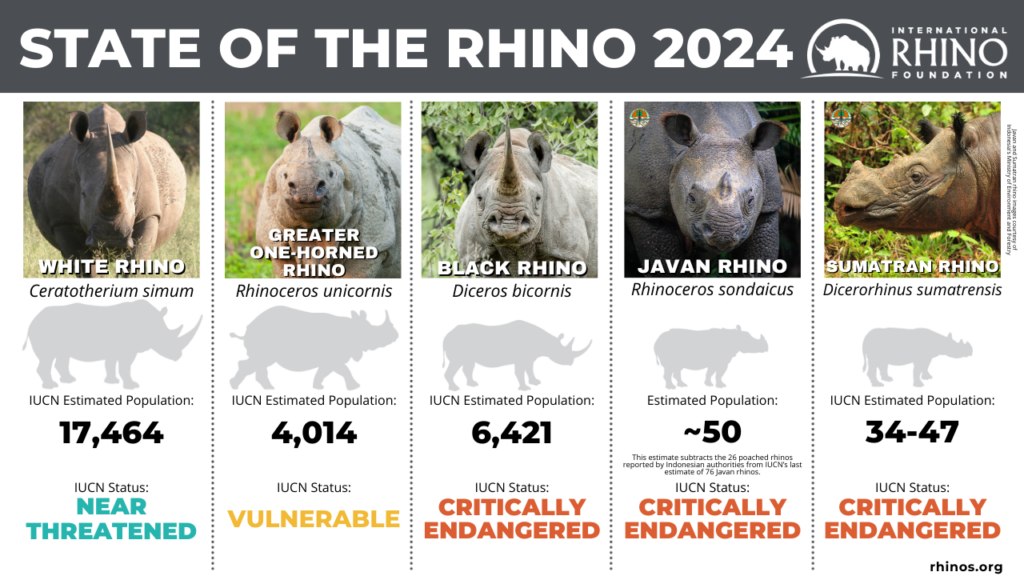
This report is dedicated to the committed individuals in African and Asian Rhino Range countries working to secure the five species of rhinos in the wild. The International Rhino Foundation especially respects and admires the tremendous sacrifices made by frontline rangers in rhino bearing areas. We are proud to support these efforts.
State of the Rhino
Why is it important to talk about rhino numbers?
Successful conservation requires regular, accurate data on wildlife numbers and trends in order to manage populations, identify the risk of extinction and develop conservation strategies. In other words, you can’t save something if you don’t know what you have. Understanding population trends, threats and opportunities is the only way to know how and where to prioritize protection efforts and limited resources to target areas where conservation actions will have the most impact. This is particularly true for rhinos, who not only face environmental threats like habitat loss, fragmentation and invasion of alien plant species, but the devastating additional complication of poaching.
Yet obtaining reliable data on exact population numbers is a herculean task, complicated by biological, environmental and socio-political obstacles. The ability to obtain accurate rhino numbers varies by country, the species and current political climate in every rhino range state.
Many rhino range states don’t conduct rhino counts every year so are unable to provide annual population estimates – and even when they do they don’t always publish the data. Countries that are part of the Convention on International Trade in Endangered Species of Wild Fauna and Flora (CITES), the international agreement between governments created to ensure that wildlife trade doesn’t impact species’ survival, generally report population counts every two to three years in conjunction with the CITES Conference of the Parties. While understanding rhino population numbers is considered by most to be essential, collecting and sharing data can be prohibitive or problematic.
The threat of poaching adds a layer of complexity to releasing information about rhino populations. Publishing data on the size or locations of populations for a taxon like rhinos that are highly sought after for the illegal wildlife trade could assist criminal syndicates in identifying target areas to poach. Governments may also avoid releasing population data to downplay news on any increasing populations.
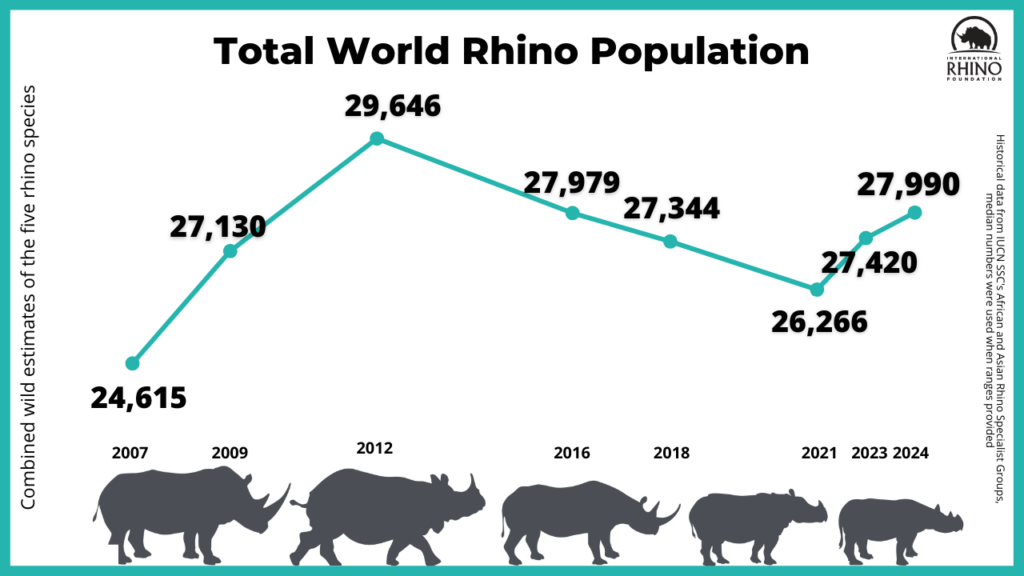
On the other hand, some governments may want to avoid the embarrassment of sharing news of decreasing population numbers. And publishing raw population data without proper context can be misleading. For example, an increase in numbers might suggest rhinos are thriving when significant threats are still present, giving people a false sense of security or complacency.
Logistically, rhino populations in many areas are extremely difficult to count. Rhinos are often solitary and can be difficult to spot, especially in dense vegetation. Their shy behavior makes it hard to track them consistently, leading to underestimation in population counts. Whether they are roaming over vast landscapes like Kruger National Park in South Africa or quietly traversing through dense jungles such as Ujung Kulon National Park in Indonesia, surveying these areas is difficult and expensive, requiring significant resources such as aerial surveillance, camera traps and tracking teams. Additionally, animals can disperse over borders between countries, risking either double counting or individuals being missed entirely.
Governmental wildlife agencies may not have sufficient resources to invest in frequent and comprehensive population assessments. There is no single standard for counting rhinos. Different countries use various techniques tailored to their species and unique habitat. In India and Nepal rhinos are counted every 3-4 years by large teams of people riding elephants in order to spot rhinos while staying safe from rhinos and other wildlife. In some countries camera traps are used to identify and estimate rhino populations. And in others helicopters and aerial teams are used to count rhinos over vast landscapes. In Namibia rhino rangers track rhinos by vehicle and record every single rhino using an ear notching identification method. No method for counting rhinos is 100% accurate every time, but scientists make their estimates with the best available data.
Rhino conservation is nuanced and challenging, even with accurate population assessments. But when this most basic of conservation needs goes unfulfilled, it hinders rhino protection and preservation around the globe. The aim of the International Rhino Foundation’s (IRF) annual State of the Rhino report is to not only provide accurate numbers and trends, but to also share the context in which they occur to support rhino conservation efforts in Africa and Asia.
In this report, you will see total population estimates for black and white rhinos as of the end of 2023, while individual rhino range country data may only be as recent as of the end of 2021. For countries where there are conflicting numbers, either through different census methods or from different sources, we have provided that information as well. And for all five species, we have included our thoughts on population trends – where we are most concerned and where we’re celebrating successes. All of this is in service to the collective work IRF conducts with our partners around the globe, helping ensure all five rhino species survive.
African Rhinos
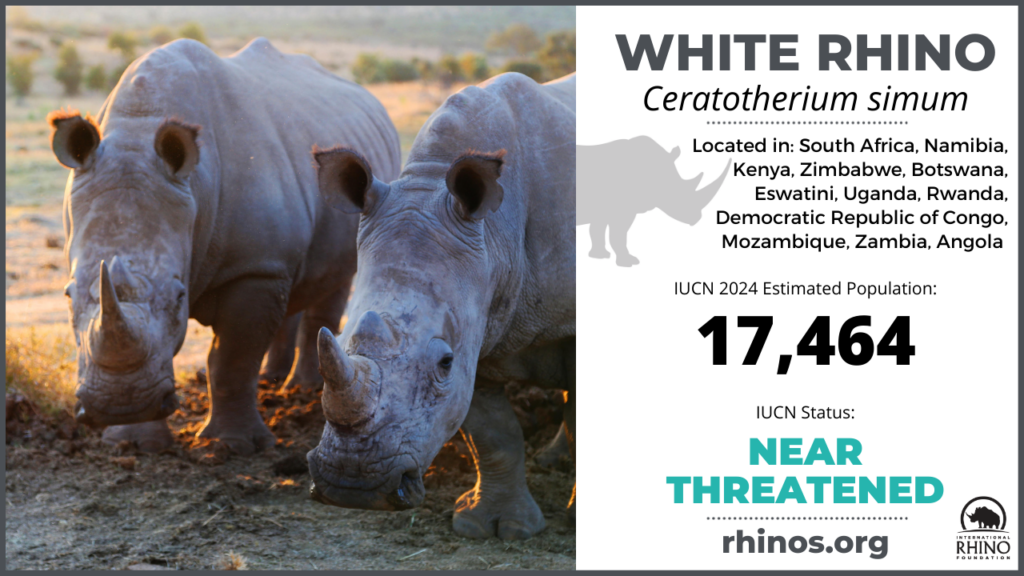
White Rhino
IUCN Estimated Population and Status: 17,464; Near Threatened
White rhinos (Ceratotherium simum) are the most populous of the five rhino species with approximately 17,464 animals across 11 countries in Africa. There are two white rhino subspecies, southern (C.s. simum) and northern (C.s. cottoni), but as there are only two northern white rhinos left in the world – both females – that subspecies is considered functionally extinct. Historically as a species, white rhinos made an incredible comeback from fewer than 100 individuals in the early 1900s to more than 21,000 at the end of 2012.
Unfortunately, from 2012 to 2021, their large numbers made them the primary target for rhino poachers, who are part of transnational criminal syndicates looking to sell rhino horn on the black market. During this period, white rhino numbers decreased by 24% to an estimated 15,942. Although the number of rhino deaths annually has decreased since the most recent peak in 2015, poaching remains the biggest threat to rhinos, and white rhinos in particular bear the brunt. Last year, the International Union for the Conservation of Nature (IUCN) Species Survival Commission’s African Rhino Specialist Group (AfRSG) announced the first population increase for the white rhino species in over a decade. They have recently announced another 3.4% increase for white rhinos, bringing their species estimate to 17,464 as of the end of 2023.
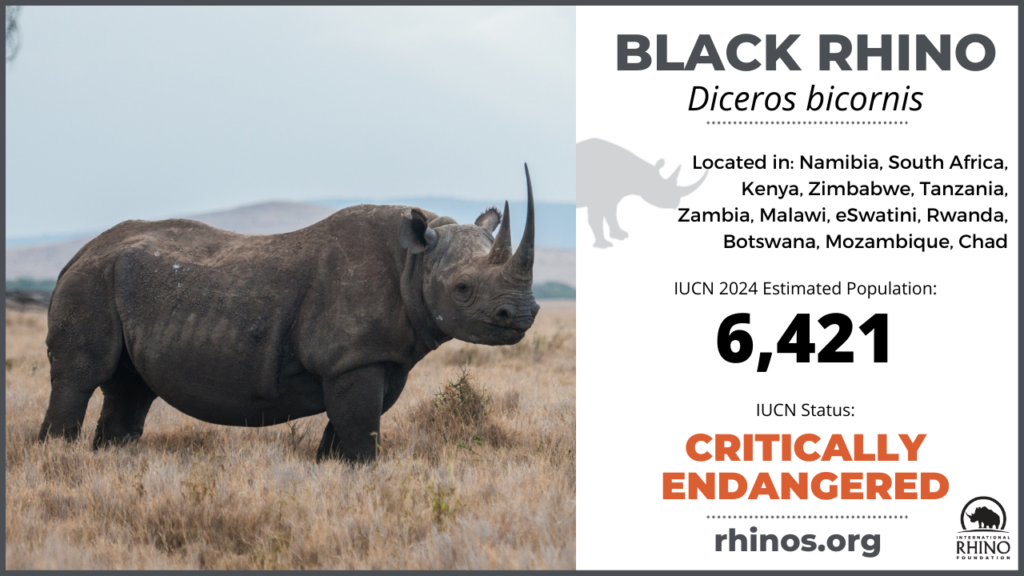
Black Rhino
IUCN Estimated Population and Status: 6,421; Critically Endangered
Black rhinos (Diceros bicornis) can currently be found in 12 countries in Africa, totalling an estimated 6,421 individuals. The black rhino population is made up of three subspecies, including approximately 2,583 south-western (D.b. bicornis); 2,450 southern (D.b. minor) and 1,388 eastern (D.b. michaeli). A fourth subspecies, the western black rhino (D.b. longipes), was declared extinct in 2011; its last evidence of existence was in Cameroon in 2006.
At one time, black rhinos were the most common of the world’s rhino species and records indicate there could have been as many as 100,000 throughout Africa in 1960. By 1970, poaching had reduced the population to approximately 65,000 and black rhinos continued to decline precipitously until a low of about 2,300 individuals in the mid 1990s. Thanks to intense protection and management efforts, black rhino populations stabilized and, despite ongoing poaching pressure, have increased by approximately 28% over the last decade. The AfRSG recently reported that the total black rhino population as of the end of 2023 is now approximately 6,421 – a 1% decrease over the last year, due mostly to the concentrated poaching seen in Namibia and South Africa’s Hluhluwe iMfolozi Park. This slight decrease is the first noted for black rhinos since 1995, and hopefully only a one-time pause in their otherwise steady growth.
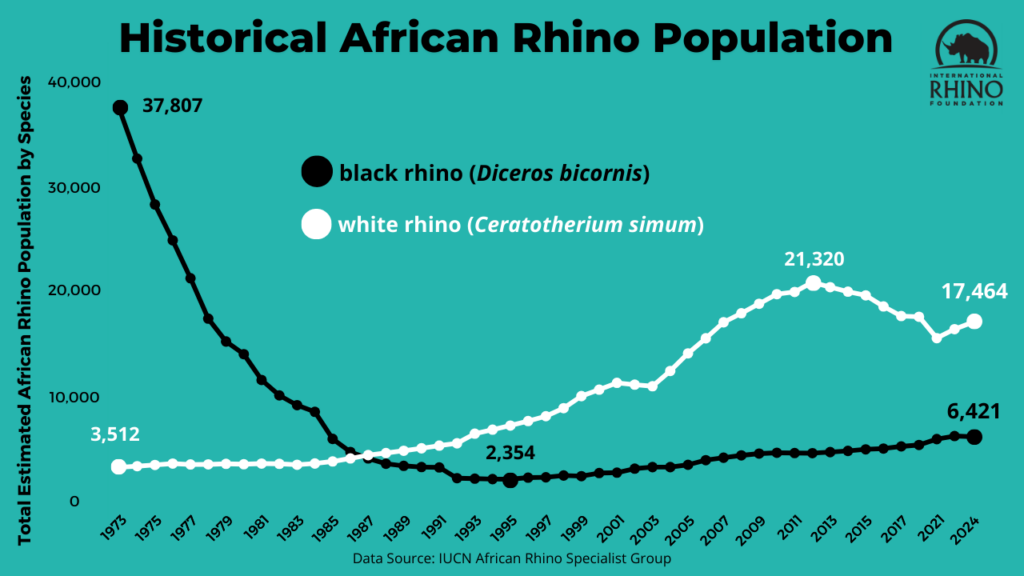
African Rhino Populations and Poaching
| African Rhino Range Countries | Estimated Rhino Population, by species (as of the end of 2021, unless otherwise noted) | Last-Reported Rhino Poaching Count |
| Angola | 3 white rhino | Not reported |
| Botswana | 265 rhino (23 black, 242 white) | 9 in 2023 |
| Chad | 7 black rhino | 0 in 2023 |
| Democratic Republic of Congo | 20 white rhino | 1 in 2023 |
| Eswatini | 146 rhino (48 black, 98 white) | 0 in 2023 3 total since 2006 |
| Kenya | 1,811 rhino (938 black, 873 white) | 4 in 2023 |
| Malawi | 56 black rhino | 0 in 2023 |
| Mozambique | 16 rhino (2 black, 14 white) | 0 in 2022 2023 not reported |
| Namibia | 3,612 rhino (2,196 black, 1,416 white) | 62 in 2023 |
| Rwanda | 58 rhino (28 black, 30 white) | 0 in 2023 |
| South Africa | 16,056 rhino* (2,065 black, 13,991 white) *estimate as of the end of 2023, reported Aug 2024 | 499 in 2023; 229 from Jan to Jun 2024 |
| Tanzania | 212 black rhino | 0 in 2023 |
| Uganda | 35 white rhino | 0 in 2023 |
| Zambia | 66 rhino (58 black, 8 white) | 5 in 2023 |
| Zimbabwe | 1,033 rhino (616 black, 417 white) | 6 in 2023 |
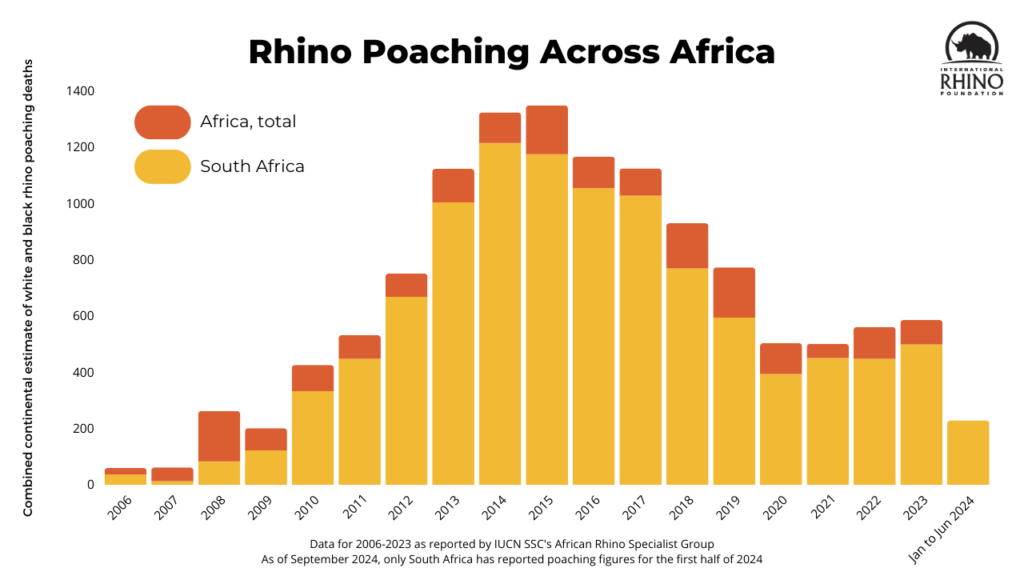
Spotlight on Kruger National Park
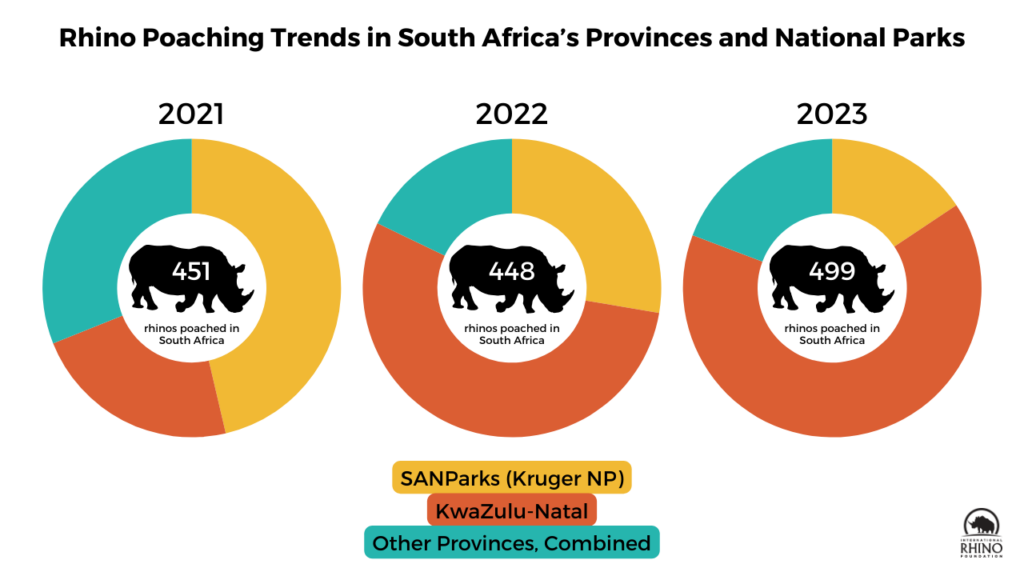
Long-embattled Kruger National Park (KNP) has maintained its significantly reduced poaching rate in 2024 thanks to the Park’s vigilant focus on a suite of core activities and areas. Kruger’s extensive and ongoing dehorning program of all rhinos in core areas continues to save rhinos. Strong collaboration between South Africa National Parks’ (SANParks) internal departments and external stakeholders is proving to re-energize and coordinate essential players. The Park has prioritized the dismissal, arrest, conviction and prosecution of SANParks staff (including Field Rangers) that were enabling poachers or involved in poaching activities themselves. Field Rangers being handed down prison sentences has sent a strong message regarding internal involvement and corruption.
Under the leadership of the Head Ranger, the continued implementation of the KNP Ranger Services Integrity Management Plan (IMP) is not only assisting in the Kruger National Park, but is setting a benchmark for other parks to follow. Indeed, it is being hailed as a model around the globe. The IMP is a holistic approach that assesses the drivers and dynamics of corruption, and then addresses these with a comprehensive set of actions that focuses on building individual integrity and organizational resilience to corruption. This includes the roll out of polygraph testing, as well as financial literacy, wellness and skills development programs for staff.
It is vital for state rhino park authorities to entrench and enforce these practices. Severe budget cuts across all State reserves in South Africa will have dire consequences for these rhino populations, and without a swift strategy to proactively address capacity and build strong capabilities, the poaching pressures that have plagued Kruger and other state parks will surely be repeated in new areas.
There are many lessons to be learned from Kruger’s intense history with rhino poaching. Our hope is that parks and reserves around the world can learn from Kruger’s experience and we can collectively work to stem rhino poaching.
Asian Rhinos
Greater One-horned Rhino
IUCN Estimated Population and Status: 4,014; Vulnerable
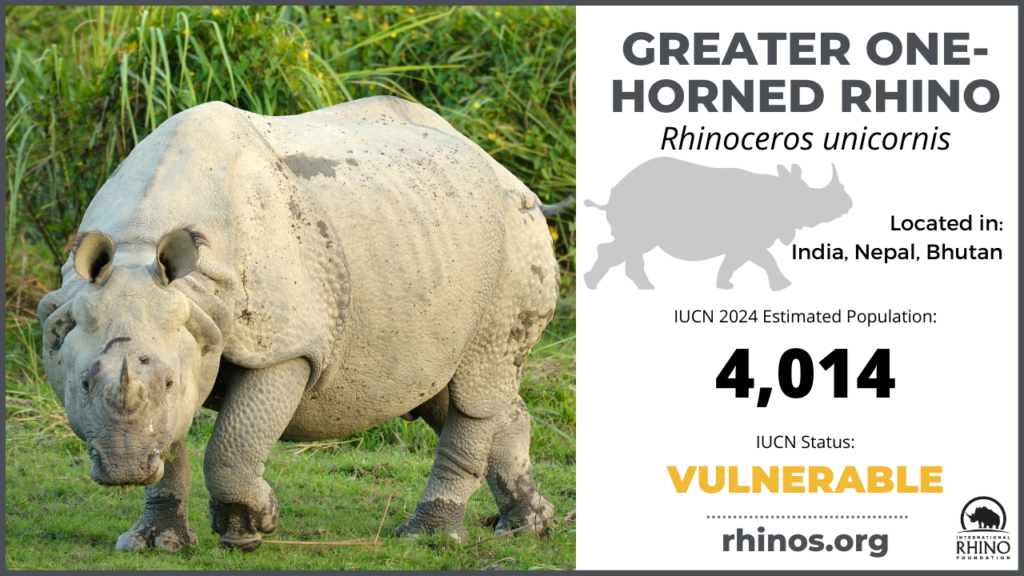
Greater one-horned rhinos (Rhinoceros unicornis) reside primarily in India and Nepal, though there is a population that occasionally crosses into Bhutan. Bhutan, India and Nepal work together to implement a trans-boundary management strategy for the greater one-horned rhino. Thanks to this collaboration and strict government protection and management, the greater one-horned rhino population has steadily grown from fewer than 100 animals over the last century, increasing by about 20% over the past decade.
Though the greater one-horned rhino population is growing, the species is still classified as Vulnerable. Poaching remains a significant threat, and the species has been driven from many of the areas where it used to be common. Its full recovery depends not only on protecting rhinos where they have managed to survive, but also reintroducing them to places from which they’ve disappeared. Another significant landscape-level threat to greater one-horned rhinos is the prevalence of invasive species, which choke out native rhino food plants and limit the amount of habitat available. There is also some concern that greater one-horned rhinos could be one of the hardest hit by stronger monsoon seasons and limited space and resources cause habitat disruption and increase the threat of human-wildlife conflict.
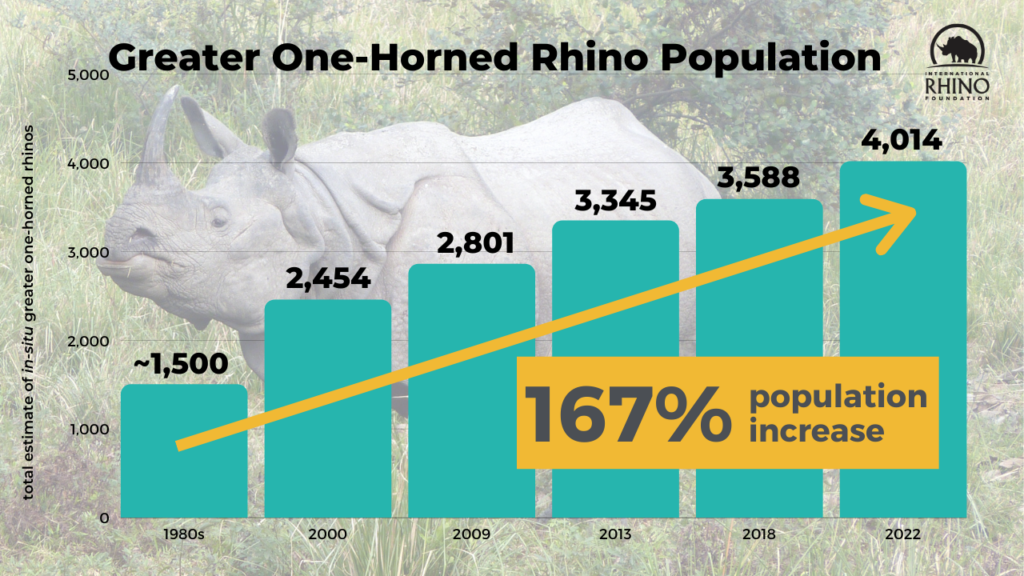
Javan Rhino
IUCN Estimated Population and Status: 76*; Critically Endangered
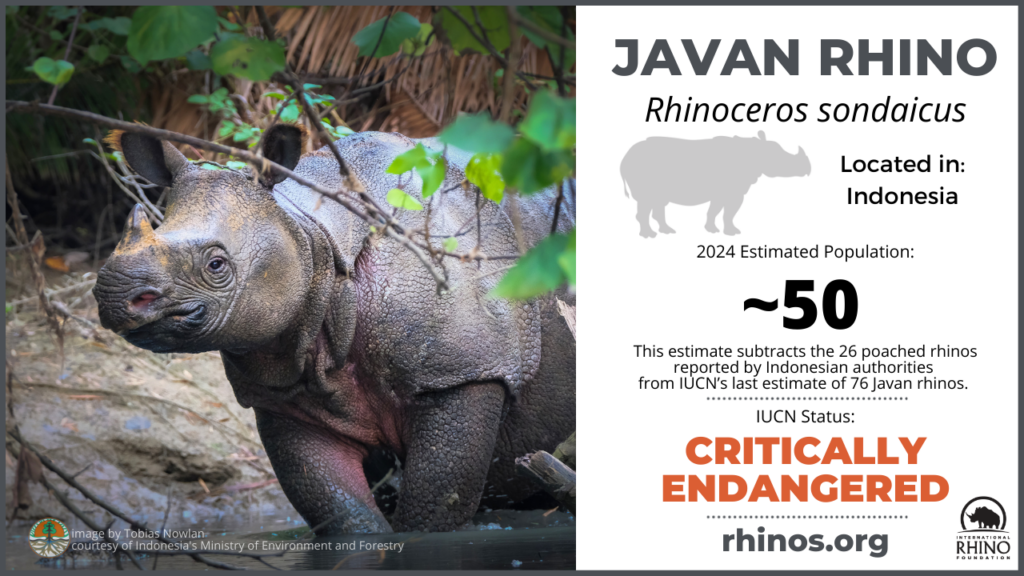
*The discovery of a major poaching operation in Ujung Kulon National Park, where a reported 26 rhinos were poached from 2019 to 2023, has created uncertainty about the number of Javan rhinos currently left in the Park, as well as their population trend. The International Rhino Foundation believes that an estimate of 50 Javan rhinos is likely to be more accurate, though the Park’s monitoring teams will need to confirm the annual camera-trap count of individuals.
Since the 2011 death of the last Javan rhino (Rhinoceros sondaicus) in Vietnam, the species now only exists in one country, in one national park – Indonesia’s Ujung Kulon National Park (UKNP). This year, Indonesian Police are investigating the killing of 26 Javan rhinos in Ujung Kulon NP from 2019 to 2023 and the primary poacher has been sentenced to 12 years in prison. If the reports by Indonesian police are accurate that 26 Javan rhinos have been killed, the current Javan rhino population, which was last estimated to be 76, would now stand at 50 individuals. We encourage the Indonesian government to reassess the current Javan rhino population as well as determine the male-female ratio in order to bolster efforts to secure this imperiled species.
Sumatran Rhino
IUCN Estimated Population and Status: 34-47; Critically Endangered
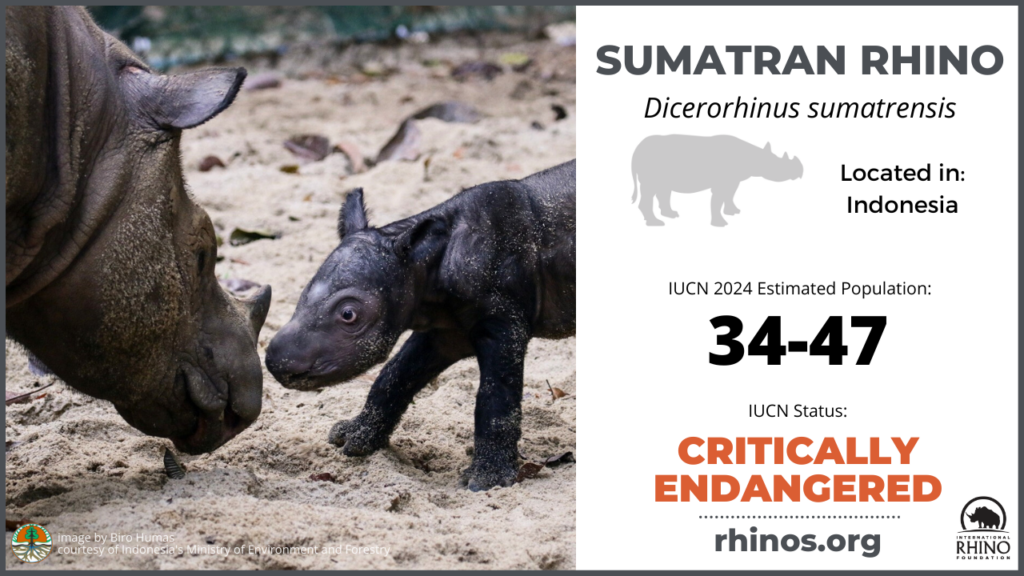
Sumatran rhinos (Dicerorhinus sumatrensis) are also extant in just one country, Indonesia. The IUCN SSC Asian Rhino Specialist Group (AsRSG) reports that there are up to 4 isolated populations and as many as 10 subpopulations of Sumatran rhinos left in Indonesia. Only one of these wild populations, in Gunung Lesuer, is believed to have enough individuals to be viable. Uncertainty is and has been the key word for tracking Sumatran rhino population trends over time. As this reclusive species seems to disappear further into dense jungles, direct sightings have become rare and indirect signs like footprints are getting harder to find.
The government of Indonesia reports that there are no more than 80 Sumatran rhinos in total, while the AsRSG specifies that the actual count could be as low as 34-47 individuals with no single subpopulation having more than 30 rhinos. There has been no evidence of Sumatran rhino poaching found for over a decade – there also have been no naturally occurring carcasses discovered either, making the species’ disappearance even more of a mystery. The beacon of hope for the species is the breeding program at the Sumatran Rhino Sanctuary, a protected, semi-wild facility in Sumatra that has now produced five calves and continues its breeding efforts to create an insurance population of rhinos.
Asian Rhino Populations and Poaching
| Asian Rhino Range Countries | Estimated Rhino Population, by species (as of the end of 2021, unless otherwise noted) | Last-Reported Rhino Poaching Count |
| India | 3,262 greater one-horned rhino | 2 in 2023; 2 to date in 2024 |
| Nepal | 752 greater one-horned rhino | 4 in 2023 |
| Bhutan | no permanent rhino population; greater one-horned rhino range overlaps with India’s Manas NP | none |
| Indonesia | 84 to 97 rhino (~50 Javan*, 34-47 Sumatran) *This estimate subtracts the 26 poached rhinos from IUCN’s last estimate of 76 Javan rhinos at the end of 2021. | 26 Javan rhinos reported poached from 2019-2023 |
Rhino Headlines
Research
- New research finds it is “implausible” to gain any health benefits from consuming rhino horn – and it could potentially be toxic.
- Some hope to deter poaching and devalue rhino horn by implanting horns with radioactive devices.
- Study finds lasting success in India’s 15-year rhino reintroduction project – Indian Rhino Vision 2020.
- The death of a southern white rhino surrogate revealed that she was 70 days pregnant from a lab-created embryo using in vitro fertilization – the first evidence of a viable IVF pregnancy in rhinos.
- Without drastic action, climate models predict big problems for Africa’s rhinos. Climate scientists analyzed ‘business-as-usual’ models for 2050 and 2085 in key rhino habitats, predicting hotter and drier environments than rhinos may be able to stand.
Illegal Wildlife Trade
- Scientists at the Australian Museum in Sydney developed a rapid DNA test for rhino horns that can help prosecute poachers and traffickers by quickly identifying the species the horn was taken from, and potentially linking samples to individual carcasses.
- In the United Nations’ World Wildlife Crime Report 2024, rhinos were named as the species most affected by illegal wildlife trade from 2015 to 2021, as summarized by the World Economic Forum.
- The United Nations is investigating allegations that a North Korean diplomat in South Africa attempted to traffic $65 million worth of rhino horns in 2022, in addition to other wildlife trafficking schemes.
- A trafficker was sentenced to 12 years in prison in Vietnam for attempting to smuggle 12 kgs of rhino horn from Angola. Conservation groups like Education for Nature Vietnam hope that these increasingly strict penalties will serve to deter future wildlife crime.
- South Africa’s Skukuza Regional Court continues to hand strong convictions to rhino poachers. In July 2024, the “Rhino Court” sentenced convicted poacher Dominic Mnisi to 50 years in prison for his crimes. He then warned people to not get involved with poaching syndicates, as they “destroyed” his life.
Global Rhino Headlines
- Chad
- In December 2023, five black rhinos were translocated from South Africa to Chad’s Zakouma National Park to join the pair living there since 2018. Prior to these moves, rhinos had been locally extinct in Chad for 40 years and the Park plans on importing another 13 rhinos by 2025 to establish a self-sustaining population.
- India
- Rhinos return to Assam wildlife sanctuary after 40 years. In December 2023, two rhinos moved themselves from Orang National Park to the Laokhowa and Burhachapori Wildlife Sanctuaries by using a newly established wildlife corridor. A total of four rhinos now reside in this newly established area, allowing greater one-horned rhinos to expand their range and population growth in Assam.
- Two rhinos were killed in a single day in Kaziranga National Park, home to the world’s largest population of greater one-horned rhinos.
- The negative impact of India’s annual floods makes headlines every year – here’s why floods are essential for these ecosystems.
- Indonesia
- Banten Regional Police announced that two poaching groups killed as many as 26 Javan rhinos in Ujung Kulon National Park (UKNP) from 2019 to 2023. The primary suspect was arrested and sentenced to 12 years in prison, the longest wildlife sentence received in Indonesia’s history.
- UKNP has started to use the Fully Protected Area (FPA) system for protecting the Park and its Javan rhinos. In addition, the Integrated Protected System (IPS) will be the long term system of protecting programs in UKNP and the new Javan Rhino Study and Conservation Area (JRSCA) has been built by UKNP in preparation of conservation breeding of Javan rhinos in-country.
- Indonesia’s Ministry of Environment and Forestry recently announced the birth of a new female Javan rhino calf to a first-time mother. A promising sign that despite previous poaching activity, the rhinos in UKNP are still breeding and having calves.
- Two Sumatran rhino calves were born at the Way Kambas National Park Sumatran Rhino Sanctuary at the end of 2023. This puts the Sumatran rhino conservation breeding program in the best position it’s ever been in. The Government of Indonesia also initiated their Assisted Reproduction Technology (ART) program for the propagation of Sumatran rhinos.
- Kenya
- Black rhinos returned to Kenya’s Loisaba Conservancy for the first time in 50 years. The 21 rhinos were translocated by truck from three locations within Kenya: Nairobi National Park, Ol Pejeta Conservancy, and Lewa Wildlife Conservancy.
- Mozambique
- In August 2024, two rhino horn traffickers were sentenced to 27 and 24 years in prison in Mozambique. Simon Valoi was considered one of the most prolific rhino horn poaching bosses in South Africa, targeting Kruger National Park with his accomplice Paulo Zucula. The 2022 arrest of Valoi and Zucula and these strong sentences represent a significant blow to illegal wildlife trade in southern Africa.
- Namibia
- With rhino poaching on the rise in the first quarter of 2024, Namibian officials are calling for all hands to address this urgent poaching crisis.
- Nepal
- In September 2024, Chitwan National Park arrested 34 suspected rhino poachers – their largest arrest ever. The Park is home to the world’s second largest population of greater one-horned rhinos and reported four rhino poaching deaths in 2023.
- The National Trust for Nature Conservation’s work maintaining 300 hectares of grazing lawns for rhinos within Chitwan National Park has resulted in a 65% increase in the number of rhinos using the managed grasslands and a 43% decrease in rhino deaths caused by toxic invasive plant species in the past year.
- South Africa
- African Parks successfully translocated the first 40 of 2,000 rhinos set to be rewilded throughout Africa. The first 40 were moved to the Munyawana Conservancy in South Africa and African Parks has since moved an additional 120 rhinos from the former captive-breeding operation it acquired in 2023.
- The Minister of Forestry, Fisheries and the Environment, reported a slight decrease in rhino poaching for the first six-months of the year compared to 2023. Following patterns from the last three years, the vast majority (63%) of the 229 South African rhinos killed this year were poached in KwaZulu-Natal province, most in one state park – Hluhluwe iMfolozi (HiP). The Minister reports almost a 50% drop in poaching in May and June, attributing it to the dehorning of over 1,000 rhinos in HiP since April. While the much larger Kruger National Park used to bear the brunt of rhino poaching, their consistent use of dehorning as a deterrent as well as adoption of a comprehensive Integrity Management Plan for staff are two examples of a suite of interventions that have enabled them to turn the tide on poaching.
- Rwanda
- Olmoti, a black rhino raised at a zoo in England, gave birth to her first calf in Rwanda’s Akagera National Park. Olmoti was one of several rhinos transferred to Akagera in 2019 in an effort to rebuild the country’s rhino population. Olmoti and her new calf were spotted by camera trap and aerial patrols in July 2024 and continue to do well, according to African Parks.
- Zimbabwe
- Rhino poaching is down drastically in Zimabwe’s Lowveld Region. There were zero known poaching losses in 2023 for the first time in over 20 years. Thanks to increased intelligence and anti-poaching investment, 2023 is also the first year this century that our partners at the Lowveld Rhino Trust have not had to undertake any emergency interventions.
The threats rhinos face are nothing new, but the rhino conservation toolbox is growing everyday. While tried-and-true conservation actions such as boots-on-the-ground protection or natural breeding for Sumatran rhinos, are continuously enhanced, newer tools like Artificial Intelligence for rhino monitoring and Assisted Reproductive Technologies, like IVF, are expanding their potential in the conservation toolbox.
From Africa to Asia, every rhino species has a unique set of conservation challenges based on the environmental, socioeconomic and political realities of the province and country they reside in. IRF and our partners around the globe work to ensure the strategies and tools used for each species appropriately reflect these realities, the best available science and the resources available. Over our 33 years, we’ve gathered a collection of tools that enable us to Save Rhinos, Engage People and Protect Habitats. From population management and anti-poaching efforts to community development and capacity building to habitat restoration and rhino range expansion, these tools help create a future where all five rhino species thrive in the wild.
Rhino conservation is often two steps forward and one step back. Sometimes, as with Javan rhinos this year, it feels like a leap back. But we can’t let setbacks deter us, we have to move forward and find new paths and try new tools if old ones aren’t right for the current environment. The only way to truly fail in conservation is to stop trying at all. As of this writing, the government of Indonesia announced a new Javan rhino calf, the 5th known Javan rhino calf in the past two years, a reminder that, with protection and the right conditions, nature is resilient. While no single tool in our toolbox is a silver bullet, utilizing them together in a comprehensive and strategic intersection of science, technology and human determination can help ensure a future for all five rhino species.
This report was prepared by the International Rhino Foundation from sources including the Convention on International Trade in Endangered Species of Wild Fauna and Flora African and Asian Rhinoceroses – Status, Conservation and Trade report (August, 2022), IUCN SSC’s African Rhino and Asian Rhino Specialist Groups, and input from IRF’s rhino range country advisors and partners.

